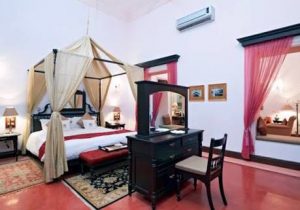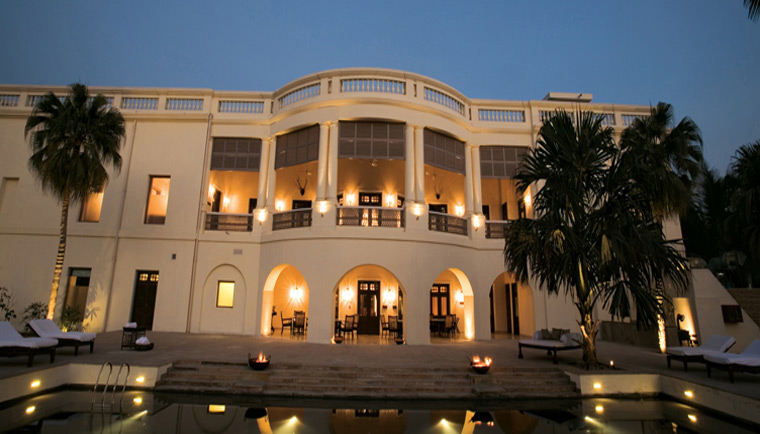
Fall in love with 'Tajness' at the Nadesar Palace
Laveena recently had a short break for Ganesh Chaturti. It is a Hindu festival, celebrated in honour of the elephant-headed god, Ganesha. Given the auspiciousness of the holiday, Laveena was keen to travel to Varanasi, regarded as one of the seven holy cities of Hindus. The Sapta Puri are seven holy pilgrimage centres in India. While Varanasi also known as Benares or Kashi is one of the seven, the others are Mathura, Haridwar, Ayodhya, Kanchipuram, Dwarka and Ujjain.
It was Mark Twain who said, “Benares is older than history, older than tradition, older even than legend, and looks twice as old as all of them put together.”
Our flight to Varanasi, landed on time and we were greeted at the airport by Prem, the guest service associate from the Nadesar Palace. As we drove to our hotel, both Prem and our English speaking chauffeur Rajendra, were eager to share their knowledge of this blindingly colourful city. We were told that Varanasi is one of the world’s oldest cities, dating back to the 11th century BC. Rajendra enthusiastically explained that the moment our vehicle entered the city of Varanasi, 50 percent of our bad karma and our sins would forever be washed away. Prem was quick to add that a holy dip in the river Ganges would do the rest and ensure complete purification from head to toe, but he warned that the sacred waters over time had been polluted beyond measure and that we may wish to opt instead for a more luxurious cleansing which was on offer at the Palace - The signature Abhisheka Experience, a treatment in which water from the holy Ganges would be gently poured upon us, to the accompaniment of other ancient ceremonial rituals.

The Nadesar Palace is a 40-minute car journey from the Varanasi airport. Our vehicle turned off the busy and bumpy road, crowded with humans and cows and was stopped by the uniformed guards at the entrance of The Gateway hotel. Once the brisk routine check was carried out, we drove past the hotel through another gate and entered a space surrounded by lush green lawns which were well landscaped and where the grass seemed perfectly manicured. There was a team of the palace staff waiting to welcome us and here is where the charms of Tajness, yet again surfaced so effortlessly. Laveena and I have been fortunate to have enjoyed the hospitality of the amazing Taj group at several of their properties including the Taj Mahal Palace in Mumbai, The Taj Falaknuma Palace in Hyderabad, The Taj Lands end in Mumbai, The Vivanta by Taj Madikeri, The Vivanta by Taj Bekal, The St James Court London and the Vivanta by Taj President. We have loved our stay at each of these hotels and our romance with the Taj was re-kindled when we set eyes on the grand and regal splendour of the Nadesar Palace. A turbaned man with a beautifully embroidered umbrella, a priest reciting Vedic chants, two holy attendants, one blowing a conch shell and another waiting to sprinkle on us, water from the Ganges, the endearing Wellness manager Ms. Piyali Pal and the hotel General Manager, Mr. Ashwani Anand, all waited to greet us and wish us a comfortable stay.
Adorned with a red tilak and a locally made bead necklace, we were directed to our room, one of ten at the Palace. Located up a flight of red-carpeted steps, the 1000 sq ft in size royal suite, is glorious and magnificent. Done up in a very typical and almost imposing style, the bedroom has a four-poster bed and an antique mirrored dressing table in the centre of the room. The bathroom has a cascade shower and a claw-foot bath. In the living room there is a fireplace, with antiques on the mantel place. There is a striking portrait of the Maharajah hanging on the wall. We were told that the Royal suite has hosted many an illustrious personality including the current Prime Minister of Japan, Mr. Shinzo Abe.
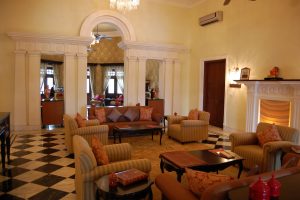
We already felt like special guests having received such a grand welcome. Add to this an upgrade to the Royal suite and we believed it couldn’t get better. But this is the Taj group and they understand hospitality better than most. They know their visitors well, as over time they make that special effort to carefully note down individual tastes and preferences of every guest.
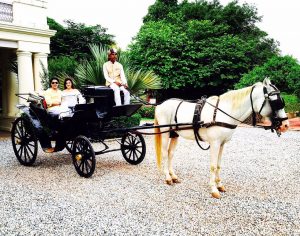
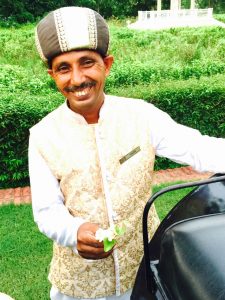
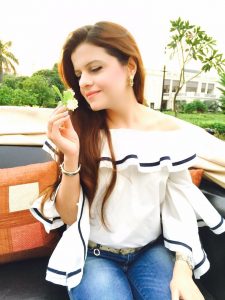
Soon after we were settled in and had a chance to freshen up, we were served lunch. Saurabh Mathur, the resident Jr. Sous Chef, is talented beyond compare. The Muslim Gharana Thali he served us that afternoon would have pleased even the most discerning Mughal Badshah. The soft and succulent Mutton Korma and the Hara Dhaniya Mirch ka Murgh were outstanding and each piece of butter soaked Naan bread I dipped into these two curries and gently placed into my mouth with my fingers, was a celebration on my palate. The mutton Dhum biryani and the Daal Dhua were also fabulous. The dessert treat, the sheer seviyan helped balance the spices with just the right amount of sweetness. A quick post-lunch walk around the property was followed by a brief nap in our luxurious room. At 5:30 pm that afternoon, we had a carriage ride planned around the palace grounds. Naseem Mohammed our carriage rider said that for generations, his family had served the royal family and that his father and his grandfather had all ridden the royal horse drawn carriage which was gifted to the Maharajah by Queen Elizabeth the 2nd. He introduced us to his white stead Munna and said that he was glad we made it before the sun had set as he had so much to show us including the peacocks, the old glass factory of the Maharajah, the mango orchards nestled among the lovely gardens and of course the jasmine and marigold fields. What intrigued me is how he communicated with Munna. Gentle and loving commands in Hindi prompted Munna to quicken or slow down his pace. I noticed to stop the horse, Naseem did not use the reigns but simply requested Munna to halt and he did. I was fascinated. At one point, near the flower garden, Naseem jumped off the carriage and walked over to pluck a jasmine flower for Laveena. We finally stopped by a shrine dedicated to the Goddess Nadesari. Naseem explained that the Palace was named after the Goddess. He said that there was an evening Aarti at the shrine and he recommended we attend it.
At 18:30 hours we had a Palace walk planned. Our hostess for the historic tour was the Wellness Manager, Piyali Pal. As she began the tour, innumerable fascinating facts were shared, each with echoes of the Raj. She started off by telling us that the Palace was built in the late 18th century by the East India Company. King George V and Queen Mary had stayed here in 1906 when they were Prince and Princess of Wales. At the time, Varanasi was called Benares. And in Varanasi, it is impossible to find a top-end luxury palace hotel coexist with such a rich and intriguing past. Rather than drift into a monologue of the many fascinating paintings on display, or the artefacts dating back decades, I recommend all guests must experience the walk and engross themselves in the more than interesting history of this marvellous Palace, sequestered in privacy, away from the hustle and bustle of this strangely magnetic disorderly city where time itself seems to have stood still.

When we were finished with our 30-minute history walk, Piyali directed us to the Nadesari shrine where the evening Aarti was about to begin. To the sound of chirruping crickets and darting dragonflies we walked toward the shrine. And as we stepped out of our footwear, a strong smell of incense greeted us. Soon started the Vedic chants from an orange-robed priest while a devotee showed his love for the Goddess by ringing the temple bell unceasingly. At the end of the Aarti, the priest walked over to us with the holy fire, over which we waived our hands and rubbed them over our heads as a mark of devotional respect.
When we returned to our rooms, our bed was turned down for the night. Rose petals were scattered on our scented bathwater. We shared a bottle of a delicious Bordeaux wine and feasted on a Satvik spread, pure and fresh vegetarian food, prepared without the influence of onion and garlic. Saurabh the Jr. sous chef explained that this was the simple food the sadhus and saints in Varanasi ate daily. Vinu Vijayan waited on us that evening and served us the Bati Choka, the Daal Fara with Badam ki chatni, the Nimona Bhat and the Banarasi Kadhi Pakori were all simply plated and presented to us for dinner. Later we stepped out in the ornamental garden behind the magnificent pool for a brief after-dinner walk. Shortly after we retired to our room for a peaceful rest.
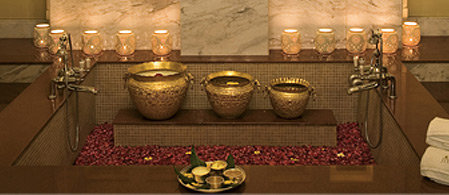

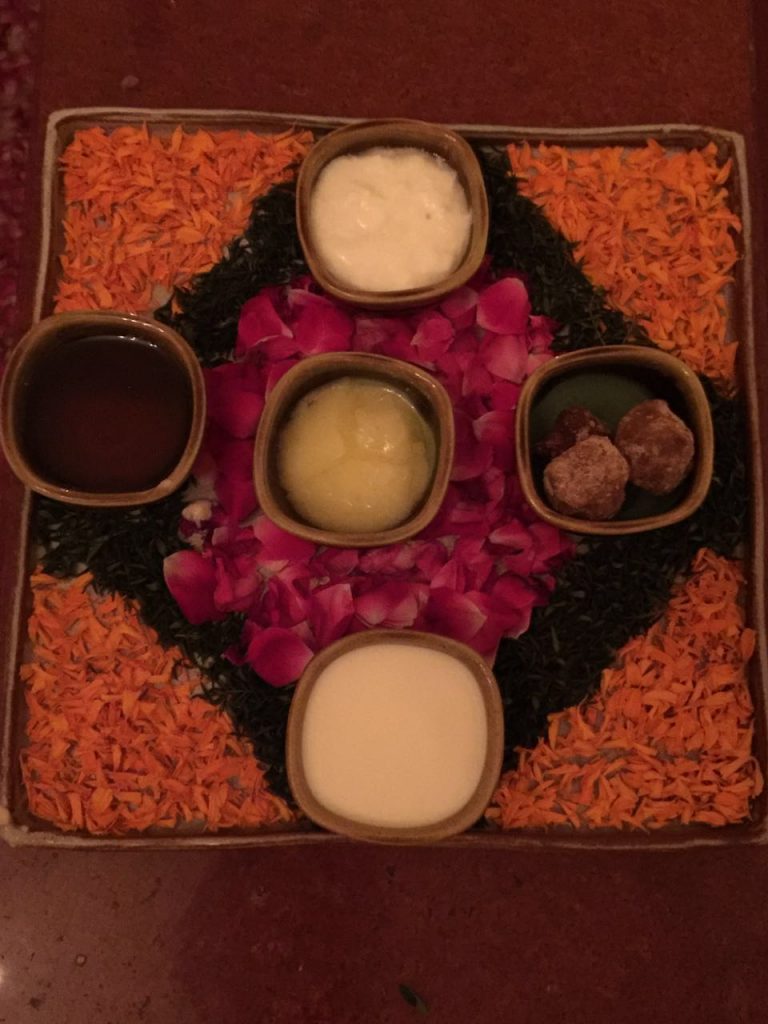
We were up bright and early the next morning and after an enjoyable yoga lesson, we had a light breakfast in the verandah. A flutist mesmerised us with his classical renditions. In the distance, we could see peacocks doing a rain dance. Laveena and I looked forward to our 120 minute Abhisheka treatment scheduled for 11:30 at the Jiva spa. We were informed that the experience involved an ancient ceremonial cleansing ritual, usually performed exclusively for the royal family ahead of their coronation. Purified water from the holy Ganges river would be gently poured down our heads after which panchamruta (five purifying nectars) would be applied to our bodies. We would then be bathed in milk which would be washed off by warm water from the Ganga, promising us a sense of total healing and rejuvenation. And while we were being bathed and scrubbed, Vedic chants would play in the background. This would be followed by an hour long deep tissue massage which would help recreate the sanctity of traditional purifying rituals. At the end of the two-hour pampering, we felt that the divinity which is believed to reside deep within each of us, surfaced effortlessly and suddenly there seemed to be an aura of complete calm and peace surrounding us both. The Abhisheka treatment is available exclusively at the Jiva spa at the Nadesar palace in Varanasi and in my opinion it is worth taking a flight for.
For lunch that afternoon Chef Saurabh had cooked up a surprise menu for us. When we were seated Dilip who was waiting on us that afternoon, served us a railway mutton curry, a dish he said originated from the traditional Kosha Mangsho of Bengal. The dish got transformed in the railway retirement rooms by a drunk British officer who asked the chefs to add potato to take away the heat from the curry and vinegar so as to make it last longer. The Dak Bungalow Chicken was a reflection of foods served to the British at Government guest houses. The chicken used was farm fed and again yoghurt, potato, and egg were added to a fiery chicken curry. Saurabh explained that Indian cuisine has been at the heart of the British food scene ever since the days of the East India Company. The company came to rule large areas of India after the Battle of Plassey in 1757. Their rule lasted until 1858 when, following the Indian Rebellion of 1857, the Government of India Act 1858 led to the British Crown assuming direct control of India in the form of the new British Raj. It is the influence of the Raj which is evident today at the Taj Palace hotels across India. Ever solicitous and always eager to please, those serving at the Nadesar Palace appear to have perfected the art of high standard hospitality. The word ‘certainly’ echoes your every request and the enthusiasm with which your ever smiling butler waits on you, makes you wish you never had to leave.
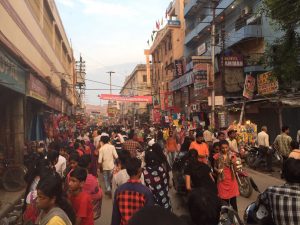
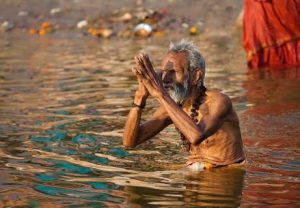
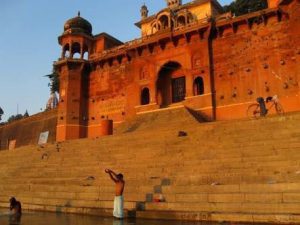
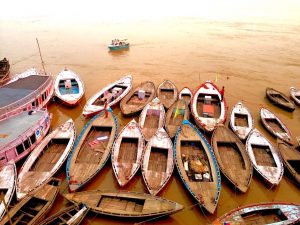
Early evening we had plans to drive deep into the mysterious city of Varanasi. According to legend, Varanasi was founded by Lord Shiva. It was known to be his favourite abode. A verse attributed to Lord Shiva, in the ancient religious text of Skanda Purana, says, “The three worlds form one city of mine and Varanasi is my royal palace therein.” Our guide ’Shailesh’ was seated by the reception and greeted us when we emerged for our evening tour. Shailesh was very well read and quoted from ancient scriptures to better explain the true holiness of the land we were so fortunate to explore. He explained that many prominent Indian saints, philosophers, poets, writers, and musicians had lived in Varanasi including the famous poet Kabir. Unrelentingly chaotic the streets we drove through had a sea of people, cows, stray dogs and holy men all jostling around harmoniously in each others happy company. At one point our car halted and we were asked to step out as the count of people was so dense in the main market that a vehicle was unable to pass through. Only two-wheelers were allowed through and a police barricade highlighted the boundary. As we walked into this ocean of humanity, I felt strangely at ease. This ancient city which has seen tides change and the world turn these past 5000 years appears to have stood relatively still and failed to keep pace with the digital development we have experienced world over. I did not see a single person on their mobile phone while walking through the marketplace. Instead, there were people actually communicating with each other, haggling at street corner stalls while purchasing vegetables and fruits or buying holy trinkets for rituals to be performed at the banks of the river.
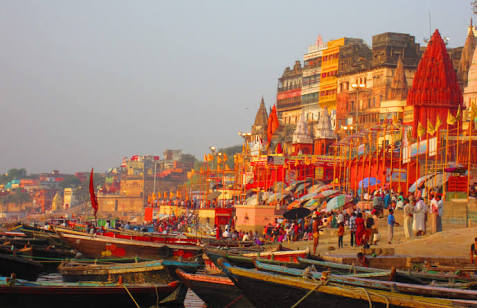
As we zigzagged our way through the marketplace, above the din of the cacophony of human voices, Shailesh tried to tell us about the 1000s of temples in Varansi. He said that amongst all the temples, the Kashi Vishwanath or the “Golden Temple,” dedicated to the Hindu god Shiva was considered by many to be the most sacred. From the many holy men we walked past, one in particular caught my attention. I asked Shailesh why he had ash smeared on his forehead. He explained that the Sadhu was an Aghori, one who engaged in post-mortem rituals. He said that the ash on his forehead and body was most likely cremation ash. A little further down the market I saw a couple of more Aghori Sadhus and attempted to smile at one of them. Not knowing what his reaction would be, I was quite pleased when he smiled right back and even gave me a quick and friendly wave with his hand. We soon arrived at the Dashwashwamedh Ghat which is known to be the most popular among pilgrims and is located along the banks of the river Ganges. There are two Hindu legends associated with the ghat. According to one, Lord Brahma created it to welcome Lord Shiva while according to another legend, Lord Brahma sacrificed ten horses during Dasa-Ashwamedha yajna performed here. Many devotees come to this ghat for a bath, to wash away their earthly sins. The ghat was built in 1748 by Peshwa Balaji Bajirao. It is here that the Ganga Aarti is performed daily, both in the morning and evening.
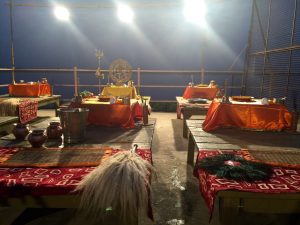
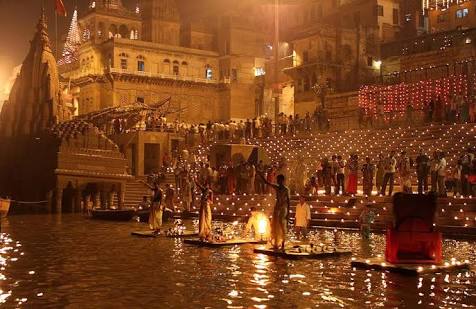
It was 6:30 pm and the Aarti was to begin at 7:00 pm. The crowds had swelled to several thousand. Since the Nadesar Palace had organised our guide, we were confident of an open passage to the very front of the gathering. When we did get to the front we saw six raised platforms, beautifully adorned. The one at the very front had a shiny red cloth on it. All of the platforms had on them several garlands, bells, conch shells, different sized brass water containers, plates with marigold flowers, a metal lamp with a large snake hood and another lamp holding tiny tea lights or diyas which were yet to be lit. While an attendant was adding his finishing touches to each platform and to the idol placed at the very front of all the platforms, I walked over to the edge for a better photo shot of the many wooden boats bobbing up and down in the rain-swollen river.


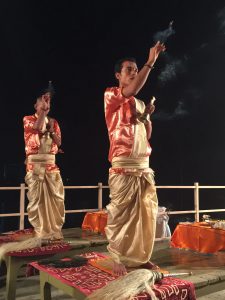
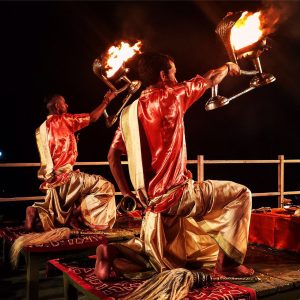
The sun was yet to set and I was lucky to have got some really fine pictures. Just before the Aarti was to start, a priest walked up to Laveena and me and said that he wanted us to assist in beginning the ritual. We felt blessed and privileged to have been picked from the vast crowd and followed him to the front where he handed us a steel plate with a lamp on it. Along with the other priests he began to chant aloud and directed us to rotate the plate in a clockwise direction. As the crowds watched the start of this magnificent ritual, we were told to put down the plate and to pour some holy water from the Ganges onto another plate in which we placed some marigold flowers, some grass and some red powder which we also marked our foreheads with. After the completion of a few holy verses we were asked to return and join the watching crowds. The aarti began with the mesmerising sounds of the conch which were blown in unison by the priests. As songs in praise of Mother Ganga were sung, incense sticks were circled around by the priests in a clockwise manner. This was followed by the rotating of the large lamp with the flickering flames of gold dancing through the still night air from the many lit tea lights or diyas. Later the priests used the metal lamp with the snake hood as part of the ritual. The performance was enlightening and made me actually feel the power of the deity. The intense faith and positive energy emanating from thousands of devotees, all concentrated toward a single ritual made me feel spiritually empowered. I almost felt like the silent devotion brought each of us present closer to divinity and after the ritual was complete, Laveena and I cupped our hands over the flame and raised our palms to our forehead in order to get the Goddess's purification and blessing.
We returned to the Palace that evening feeling purified and immensely calm. The positive effects of the Aarti lingered on. We had to return home the next day, but were not thinking about it. That evening over cocktails we interacted with some of the other Palace guests and exchanged stories about our experiences. We were told that for many Hindus, Varanasi is the beating heart of their universe. It is here that many wish to cross over into the world of eternity as Varanasi offers liberation from the cycle of birth, death and re-birth. The intimate rituals, the sights and sounds, the flower sellers, the countless number of devotees, the cloth sellers, the holy men, the smells, the many ceremonies and the endless devotion result in an alluring kind of magnetic feel which makes this part of the world fascinatingly unique, a world which Laveena and I had the good fortune of experiencing and a city which we would love to return to, once again as guests at one of the ten luxurious suites at the fantastic Nadesar Palace.
Taj Nadesar Palace (India)
• Location: Google Maps • Address: Nadesar Palace Grounds, Uttar Pradesh 221002 • Hotel website: Taj Nadesar Palace
Our Rating
- Location: 9/10
- Food and Cuisine: 8/10
- Design: 8/10
- Rooms: 9/10
- Service: 9/10
- Overall experience: 8/10
Articles you May Love To Read
The Taj Campton, San Francisco
A unique 'Runway' stay-cation at the fabulous Taj Santacruz
The Taj Mahal Palace, Mumbai
Follow me on Facebook , Instagram and Twitter for some amazing travel posts



